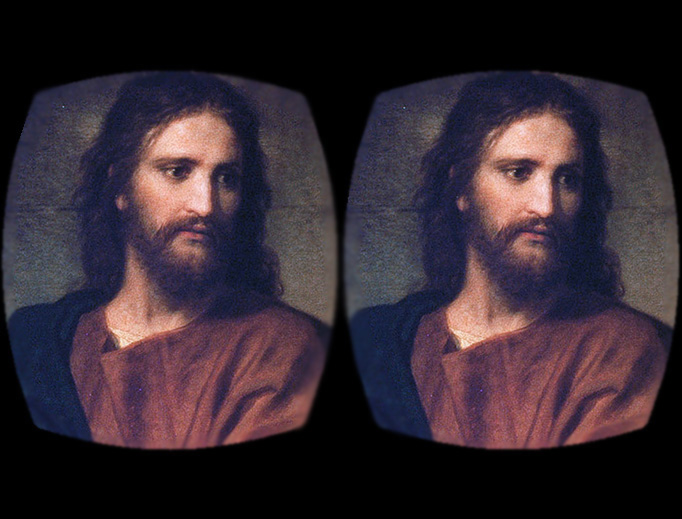Coming Soon in Virtual Reality: “The Story of Christ”

Perhaps you have heard about Virtual Reality, the latest technology that allows viewers to be immersed in a 3D, computer-generated game or movie. You put on the odd goggles, say the Oculus Rift, and suddenly you are thrown into the middle of a virtual reality Paris, where you can look all around you, and see everything (more or less) that you would see if you were actually in Paris. Or into the middle of a flaming castle with demon warriors charging at you from all directions. Or into the midst of a feast thrown for a bevy of elves by friendly, pink, curiously-dexterous unicorns.
Or, as of this coming December, into the ancient Holy Land, so that you look around at the birth of Jesus, at the wedding feast at Cana, or the crucifixion, or the Resurrection. So promises VRWerx, a company specializing in virtual reality games and movies. The film, clumsily entitled “Jesus VR—The Story of Christ” promises to transport begoggled viewers back 2000 years to the center of history, in the Incarnation, Death, and Resurrection of God.
This could be either really bad, or really not so bad, or fairly OK. Perhaps, just perhaps (by some miracle) it might be really good. Let’s think about the last and least possible.
I am not a Luddite. I use a computer. We have electricity. But I’m very wary of technology because it tends to bring a trickle of anticipated blessings, and a torrent of unexpected curses.
Yet, we must remember, the greatest Christian art and architecture in previous centuries was made using—even inventing—the latest cutting edge technology of the time. Realistic painting techniques and mathematically-based perspective were driven forward by Fra Angelico, Leonardo da Vinci, Michelangelo, and Raphael in the service of giving the Church the very best art. The same is true of architecture. All those astounding churches—Notre Dame, St. Peter’s, St. Denis—all pushed or created the latest technology and mathematics to create glorious structures dedicated to the worship of the Triune God.
We should do the same now. The very latest advances in moviemaking should be in the service of the Church. Just as the very best technical artisans gave the Church enduring masterpieces of Christian art in the 1500s, so also the very best technical artisans should be giving the Church, and the world, the very best Christian drama in the most advanced form.
We should be leading, not following. The very latest technology, the very best directors, the very best actors and actresses all making the very best movies—and in this instance, virtual reality movies.
I say this especially—ahem, feather-ruffling ahead—because there have been comparatively few really good movies that were also Catholic movies, and too many Catholic movies that are classed as “not bad, for Catholics.” Not bad is not Michelangelo.
Now for the less hopeful assessment. I greatly suspect that “Jesus VR—The Story of Christ” will be an all-too-typically mediocre and maudlin Jesus redux, primped with high-tech VR. In short, viewers will be surrounded by yet another bad Jesus movie, one that (forgive my cynical conjecture) was made not from the depths of faith but the desire to make a lot of money from the religious movie market. I hope I’m wrong about that, and “Jesus VR” outdoes “The Passion of the Christ.”
And we must add an even less hopeful (indeed, downright worrisome) aspect. The greatest driver of advances in virtual reality technology today, and the business that stands to gain the most economically for its increasingly realistic effects, is the porn industry, with a close second being the video gaming folks.
This brings into our consideration of very unpleasant truths. Whatever happens to “Jesus VR,” VR will in fact be used in two related, and horribly destructive ways. We are already far more attached to screens than actual things, far more enthralled by virtual reality than reality itself. Reality is—for many of us—simply too boring. It doesn’t stand up, in comparison, to what can be generated on a computer by high-tech wizardry. “It” here is creation, nature, living and breathing human beings—all those once wonderful things that used to cause wonder in us at our Creator, and were the context of our living out the perilous adventure upon which our present happiness and eternal salvation depend. More and more people would rather spend their time in computer fantasy worlds, even ones meant to mimic daily life (like Second Life), than the real one, and VR will only make the escape more addictive.
Advances in VR will only make this detachment from reality worse, and the worst and most distorted wrenching from reality is pornography. That’s where Oculus and those devices like it will receive their greatest use, and since the money to be made is so fantastically large—much greater than even the best “Jesus VR” will pull in—that’s what will push the technological advances in VR to new highs, or rather, lows.
Does that mean I take back all that I said at the beginning of this blog? No, but I do say it with a very large grain of salt.













